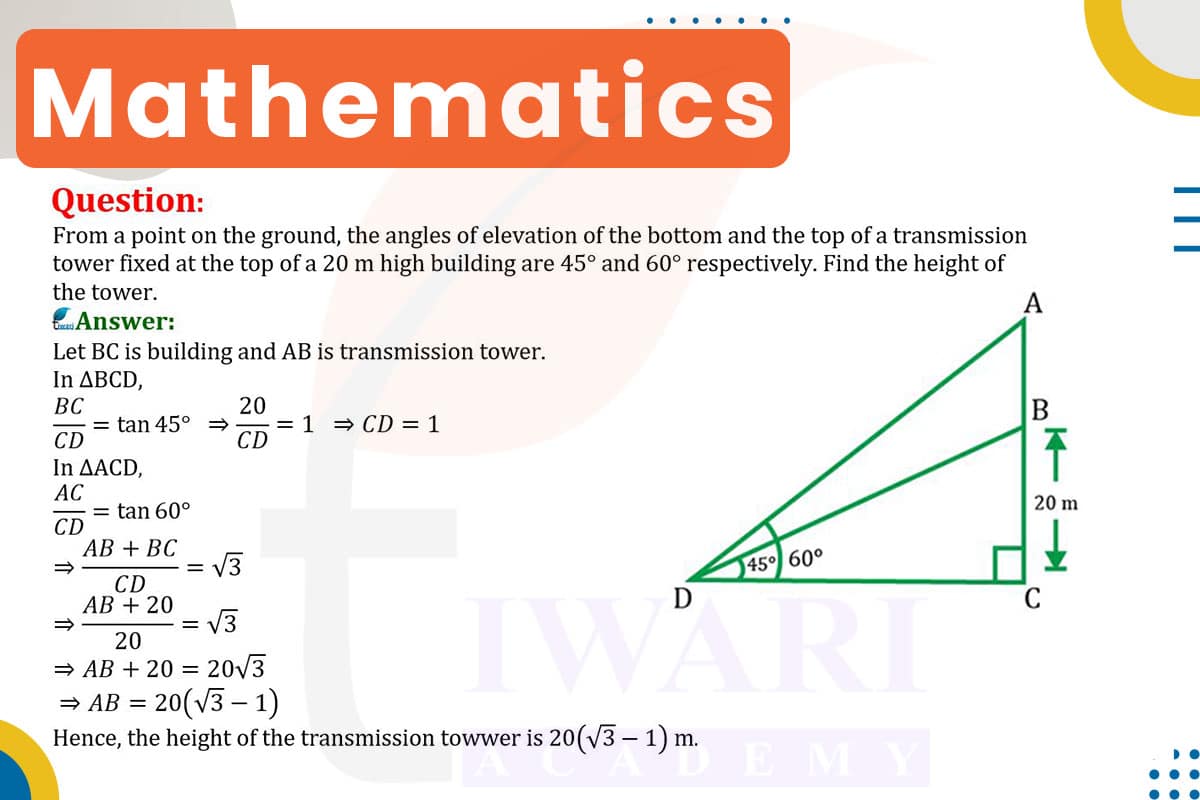To find the height of the transmission tower, we use trigonometry, specifically the tangent function. Let’s denote the total height of the building and tower as H and the height of the building as 20 m.
Angle of Elevation to Top of Tower (60°): Using tan(60°) = √3, the equation is √3 = H/d, where d is the distance from the point to the building.
Angle of Elevation to Bottom of Tower (45°): Using tan(45°)=1, the equation is 1 = 20/d. So, d = 20 m.
Substituting d in the first equation, √3 = H/20. Solving for H, we get H = 20√3 m. The height of the tower is H − 20 m, which is 20√3 − 20 m, approximately 14.64 meters. Therefore, the height of the tower is about 14.64 meters.

Let’s discuss in detail
Trigonometric Analysis in Structural Height Measurement
Trigonometry, a crucial branch of mathematics, is extensively used in various practical applications, including architecture and engineering. One such application is determining the height of structures, such as transmission towers, when direct measurement is not feasible. The problem at hand involves using the angles of elevation to the bottom and the top of a transmission tower mounted on a building to find the tower’s height. This scenario exemplifies how trigonometry can be applied to solve real-world problems, particularly in situations where direct measurements are challenging or impossible.
Understanding the Problem: Angles of Elevation to a Tower
The problem presents a transmission tower fixed atop a 20-meter-high building. From a certain point on the ground, the angles of elevation to the bottom and the top of the tower are 45° and 60°, respectively. The goal is to determine the height of the transmission tower. This setup forms two right-angled triangles – one from the point to the top of the tower and another from the point to the bottom of the tower (top of the building).
The Role of Tangent in Angle of Elevation
In trigonometry, the tangent of an angle in a right-angled triangle is the ratio of the length of the opposite side to the length of the adjacent side. This function is particularly useful in scenarios where the height of an object (opposite side) needs to be determined from a specific distance (adjacent side). By applying the tangent function to the given angles of elevation, we can calculate the distances involved and, subsequently, the height of the tower.
Calculating the Distance to the Building
First, we calculate the distance from the point to the building using the 45° angle of elevation to the building’s top. The tangent of 45° is 1, so the equation is tan(45°) = 20 /d, where d is the distance. Since tan(45°) = 1, it follows that d = 20 meters. This distance is crucial for calculating the total height from the point to the top of the tower.
Determining the Total Height to the Tower’s Top
Next, we use the 60° angle of elevation to find the total height from the point to the top of the tower. Applying tan(60°) = √3, the equation is √3 = H/20, where H is the total height. Solving for H, we get H = 20√3 meters. This height includes both the building and the tower.
Calculating the Transmission Tower’s Height
The height of the transmission tower is the total height minus the building’s height. Therefore, the tower’s height is 20√3 − 20 meters, which simplifies to approximately 14.64 meters. This calculation not only demonstrates the practical application of trigonometry in determining structural heights but also highlights the importance of mathematical principles in engineering and architectural design. Trigonometry proves to be an invaluable tool in scenarios where direct measurement is impractical, offering a reliable method for accurate estimation and design.
Discuss this question in detail or visit to Class 10 Maths Chapter 9 for all questions.
Questions of 10th Maths Exercise 9.1 in Detail


